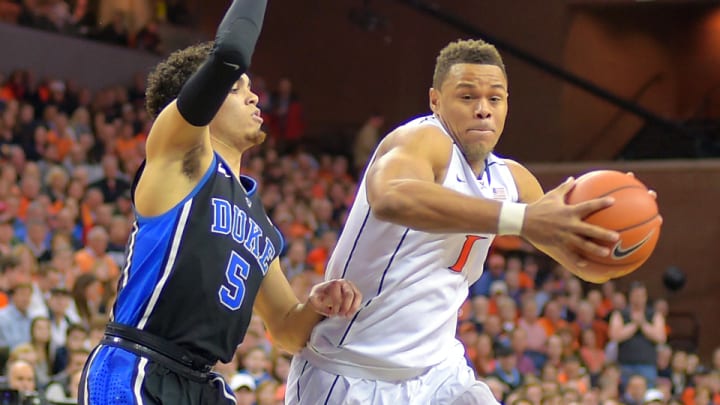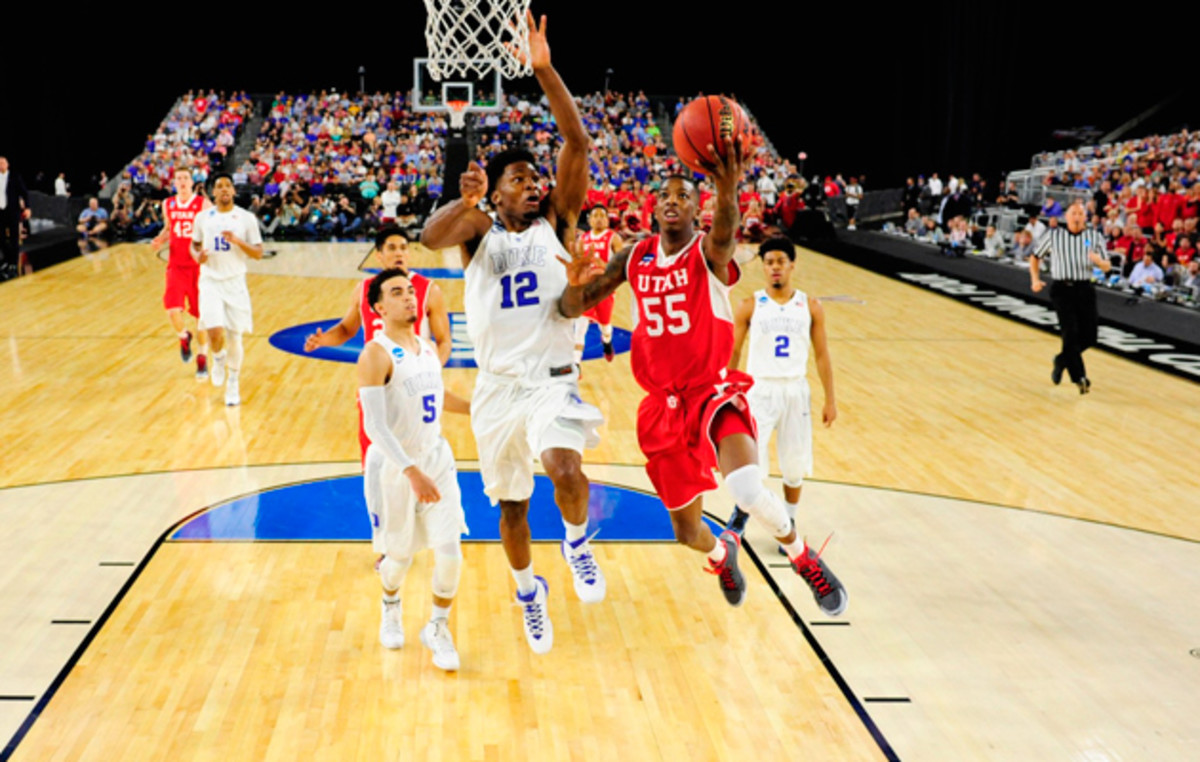Top 10 sleepers in the 2015 NBA draft

The lead up to the draft is one of the most interesting periods on the NBA calendar. While two teams compete for the Larry O’Brien trophy, the rest of the league is spending most of its time vetting a vast pool of college and international prospects. Individual workouts, medical checkups, and interviews should help front office executives make more informed decisions, but players continue to move up or down draft boards into June even though most of them haven’t played a regulation game in at least a month. The process is incredibly hectic. Misevaluation is unavoidable.
Consider the list below our attempt to sort through the chaos and pinpoint players who could outperform their projected draft slot. SI.com’s 10 draft sleepers encompass a wide range of talent—from possible lottery picks to fringe first rounders to players who may not even hear their names called at all.
Tyus Jones, PG, Duke (SI Big Board: 18)
Jones isn’t considered part of the elite echelon of guards in this class. Whereas the Guangdong Southern Tigers’ Emmanuel Mudiay and Ohio State’s D’Angelo Russell are viewed as surefire top-10 picks, many project Jones to be selected outside of the lottery. Jones doesn’t possess great size for his position and is not an elite athlete, but he makes up for physical deficiencies in other areas. Jones is a skilled distributor, possesses a tight handle and has a great feel for the game. He displayed so much poise under pressure during his lone season at Duke—which concluded with him leading the Blue Devils to a national championship and being named the Final Four’s Most Outstanding Player—that he earned the nickname “Tyus Stones.” Jones may not be capable of playing starter’s minutes in the NBA right away, but he should thrive in a reserve role.
• MORE DRAFT: Jones goes from the WNBA scout team to a Duke star
Justin Anderson, SG/SF, Virginia (SI Big Board: 20)
2015 NBA draft: Needs for every team
It’s easy to envision Anderson making a big impact as a rookie for a good team selecting near the bottom of the first round but another squad would be wise to pick him before that. Anderson profiles as a prototypical 3-and-D player. While many observers rightfully lauded Virginia’s defense as a collective last season—the Cavaliers led the nation in adjusted defensive efficiency—Anderson deserves credit for the work he put in on that end of the floor. Armed with above-average quickness and length (6’11.75’’ wingspan), Anderson can stay with opposing wings and cover ground quickly to contest shots. What drove Anderson’s ascendance into first-round draft projections over the past year, however, was his improvement as a shooter. He drained 45.2% of his three-point shots as a junior, up from 29.4% the previous season.
R.J. Hunter, SG, Georgia State (SI Big Board: 25)
Kentucky’s Devin Booker has been considered a virtual lock to be selected in the lottery. Some even have Booker projected in the top 10. It makes sense: At 6’5, 206 pounds with a 6’8.25 wingspan, Booker has the prototypical size and picture-perfect stroke to be a baby-faced assassin from beyond the three-point line in the NBA. But Booker will struggle at the onset of his professional career to create open looks for himself and teammates, which is a skill Georgia State guard R.J. Hunter currently possesses. Booker is three years younger than Hunter, but that age gap shouldn’t leave Hunter to be drafted in the middle or late 20’s while Booker shakes Adam Silver’s hand after sitting in the green room. Hunter is 6’5 as well and boasts a ridiculous 6’10.5 wingspan. He’ll be just as effective a scoring threat at the next level and will add an extra element of playmaking Booker currently cannot. That combination usually has players projected in the lottery, yet Hunter is only receiving love toward the end of the first round.
• MORE DRAFT: Hunter's journey from a coach's son to NBA prospect
Delon Wright, PG, Utah (SI Big Board: 27)
Even though he was one of the best two-way guards in Division I last season, Wright may not hear his name called until the second round. That would be a mistake. The Utah product is a disruptive defender and skilled playmaker who could spark any team’s bench units. As Sports Illustrated’s Luke Winn wrote last month, Wright excelled in some statistical categories that portend success in the NBA. During Pac-12 play last season, Wright posted the conference’s second-highest steal rate, the second-highest assist rate, the fourth-highest true shooting percentage and even blocked a higher percentage of shots than every other Utah player except seven-footer Jakob Poeltl, according to KenPom.com. Detractors will point to Wright’s subpar three-point shooting and his age (23), but teams looking for instant results, if slightly less upside, shouldn’t pass on the opportunity to take Wright in the first round.

Robert Upshaw, C, Washington (SI Big Board: 29)
“Sleeper” may not be the proper category to place Upshaw. However, there’s a chance he could perform the level expected of his draft slot. Fresno State and Washington parted ways with Upshaw over a three-year span amid questions about his off-court conduct. Before the Huskies dismissed him last January, Upshaw had emerged as an elite shot-blocker; his 17.4 block percentage over 19 games would have rated as the best in the nation if maintained over the entire season. Upshaw also excelled as a rebounder on both ends of the floor and finished a high percentage of his shots around the rim. Upshaw’s package of skills suggest he could develop into a valuable frontcourt contributor in the NBA. However, there may be some reluctance to use a first-round pick on Upshaw. The team that drafts him will need to have confidence that it can help him overcome what led to his dismissals from two college programs.
• MORE DRAFT: Mock draft 3.0: Mudiay takes a tumbles on the board
Chris McCullough, PF, Syracuse (SI Big Board: 33)
'Finch' returns to offer honest evaluations of 50 NBA draft prospects
The month-and-a-half-long pre-draft process is the perfect opportunity for unheralded draft prospects to workout in front of NBA team personnel and improve their stock. Unfortunately for Syracuse freshman forward Chris McCullough, he hasn’t been able to prove his worth, having torn his ACL in mid-January. McCullough is an exceptional athlete when healthy and has the perfect makeup for the modern NBA power forward. He has great length, owning a 7’3.25 wingspan at 6’9" and can run the floor like a gazelle. McCullough has the potential to grow into a versatile pick-and-roll and pick-and-pop threat, especially if he can add muscle to his 200-pound frame. He already dives incredibly hard to the rim and can finish over bigger players. Grabbing this kind of athlete with tremendous upside on both sides of the floor so late in the first round will be a great value pick for a lucky team.
J.P. Tokoto, SG, North Carolina (SI Big Board: 42)
The North Carolina swingman is cut from the same clothe as potential lottery pick Kelly Oubre and mid-first round prospect Rondae Hollis-Jefferson, yet J.P. Tokoto is considered a second round pick. He’s long with a 6’10 wingspan attached to his 6’6 frame and can touch the rafters with this 40-inch max vertical leap. It isn’t entirely unrealistic Tokoto could have the same immediate impact in the NBA that Hollis-Jefferson has, and he’ll likely be making half of what the Arizona forward will be on a non-guaranteed rookie minimum contract. That is an incredible get for a team selecting within the first 10 picks of the second round. If Tokoto gets to the right situation with a coaching staff that can tinker his shooting mechanics, he could become one the top value picks in the entire draft.
• MORE DRAFT: Tokoto, a man of many surprises, looks for another one
Alan Williams, C, UC Santa Barbara (SI Big Board: 45)
Rebounding and shot blocking have always been the most translatable skills from college to the NBA. While Alan Williams won’t be challenging the NBA’s top athletes at the rim, his elite rebounding ability should make an instant impact in the NBA next season (think Reggie Evans). At 22, the UC Santa Barbara senior has little untapped potential to realize and his 6’8", 261-pound frame isn’t ideal for an NBA center, but Williams will likely be able to bring the high energy and tenacity on the glass he showed during his decorated collegiate career. Williams might not be an explosive leaper, but his quick feet and knack for positioning are the key to his prolific rebounding. Williams’s 14.8 rebounds per 50 minutes pace adjusted ranked fifth among all prospects in DraftExpress’s database. Pair that tremendous ability with a pleasantly surprising post game, and Williams is a clear low-risk second round draft prospect. Still, some NBA Draft experts are projecting the big man to go undrafted.
• SI VAULT: Meet senior Alan Williams: Basketball's beast of the beach
Joseph Young, PG/SG, Oregon (SI.com big board rank: 47)
The Case For: Why NCAA basketball is the best route for future NBA players
Young’s most valuable NBA skill is his shooting ability. Over four seasons in college (two at Houston and two at Oregon), Young knocked down 39% of his three-point attempts and 89% of his free throws. He possessed the ball a lot and was the focus of defensive game plans yet still ranked among the top-15 players in the Pac-12 in offensive rating during conference play, according to Kenpom.com. Young was particularly effective as a ballhandler in pick-and-rolls and as a spot-up shooter, averaging 1.12 points per possession in the latter category and 0.92 in the former, according to Synergy Sports. Young will have to adapt his game in the NBA. He’ll have a harder time manufacturing clean looks against longer, more athletic defenders, and it remains unclear whether he can avoid being a liability on the other end of the floor. In any case, Young conceivably could carve out a role as a scoring sparkplug off the bench.
Josh Richardson, SG, Tennessee (SI Big Board: 63)
Richardson didn’t garner much attention while playing for a Tennessee team that reached the NCAA tournament only once during his four seasons at the school. Still, he showcased a skillset that should translate to the professional ranks. The baseline for Richardson’s NBA appeal is his combination of length (6’10’’ wing span) and athleticism. Richardson is a strong on-ball defender who could pose a tough matchup for opposing two guards on the perimeter. Last season he posted the third highest steal rate among Southeastern Conference players during league play and earned his second consecutive all-SEC defensive nomination. Richardson also made major strides offensively in 2014-15. He led the Volunteers in assist rate while also improving his three-point shooting accuracy. What’s more, Richardson is younger (21) than his four-year college career suggests.
